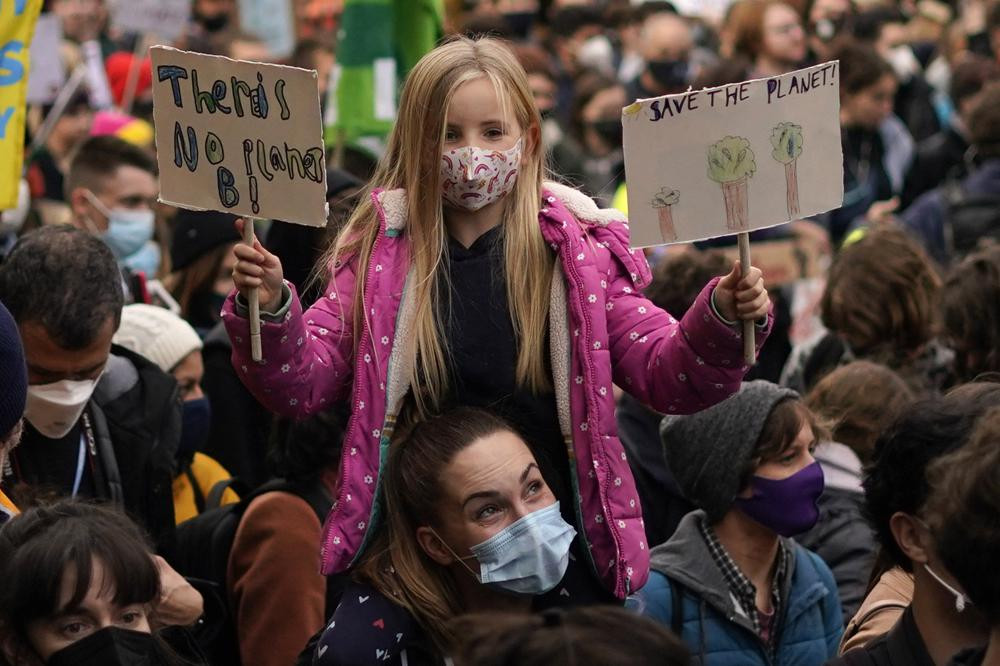Young people both inside and outside of the United Nations climate talks are telling world leaders to hurry up and get it done, that concrete measures to avoid catastrophic warming can’t wait.
Ashley Lashley, a 22-year-old from Barbardos who is on her country’s climate negotiation team in Glasgow, thought about how to communicate the need for urgency during a session on carbon trading. As she listened to other delegates debate the intricate and intractable topic that has baffled negotiators for more than six years, a phrase popped into her head: ’“blah-blah-blah.”
That’s the expression prominent teenage climate activist Greta Thunberg has started repeating to express her thoughts on the pace of government actions to curb global warming. The Thunberg-inspired Fridays for Future movement held a demonstration outside the conference venue to pressure the negotiators inside, drawing tens of thousands of participants.
And inside, the session Lashley attended droned on. She worries her fellow negotiators too easily become bogged down in minutiae and lose sight of the big picture: keeping emissions from exceeding 1.5 degrees Celsius (2.7 degrees Fahrenheit), which could wipe out some island nations and other vulnerable spots.
“Can’t you guys just wrap it up,” Lashley, one of the few young people sitting in on negotiations, recalled thinking on Friday.
Umuhoza Grace Ineza, 25, a negotiator for Rwanda, said she watches some sessions crawling along and hears other negotiators say “Ooh, let’s try this way, that way, and then we can come up with a decision next session.” Ineza says she wants to ask them if they understand how urgent limiting climate change is for the next generation.
“In my mind, it’s like do these people have children?” she said.
University of Michigan graduate student observers AJ Convertino and Evan Gonzalez said watching the sessions on the inside made them both more impatient but also more optimistic because they see the right things being said and done, if still way too slowly.
Friday was the day the U.N. conference said it was dedicating to youth. But the schedule didn’t reflect that, at times: a news conference where officials talked about youth had a panel with no members under 30, and the lunchtime events featured former U.S. Vice President Al Gore, 73, and 77-year-old John Kerry, the U.S. climate envoy.
“When I arrived at COP26, I could only see white middle-aged men in suits,” Magali Cho Lin Wing, 17, a member of the UNICEF U.K. Youth Advisory Board, said at a press event. “And I thought, ‘Hold on is this a climate conference or some corporate event? Is this what you came for? To swap business cards?’”
And except on rare occasions, young people say they are not being listened to.
“It’s our future. Our future is being negotiated, and we don’t have a seat at the table,” said 20-year-old Boston College student Julia Horchos, who is inside the conference, but hasn’t gotten into negotiating sessions.
Still, they know it’s important to be at least near the room where it all happens.
“It’s my life,” Horchos said. “Its definitely my responsibility to step up.”
Greenpeace International Executive Director Jennifer Morgan gave the conference participants and activists under 30 credit.
“Youth have brought critical urgency to the talks,” Greenpeace International Executive Director Jennifer Morgan said. “They have emphasized what is at stake for young people if the gap to 1.5 C is not closed.”
Outside the negotiations, the worry about the future was the same, but the way it was expressed was different. During the Fridays for Future demonstration in Glasgow’s Kelvingrove Park, mostly young activists carried banners with slogans such as “I have to clear up my mess, why don’t you clear up yours?” and “Stop climate crimes.”
Speaking at the Fridays rally outside the conference venue, Greta Thunberg branded the U.N. climate talks in Glasgow so far “a failure,” accusing leaders of actively creating loopholes in the rules and giving misleading pictures of their countries’ emissions
“World leaders are obviously scared of the truth, yet no matter how hard they try, they cannot escape it,” the 18-year-old Swedish activist said. “They cannot ignore the scientific consensus, and above all they cannot ignore us - the people, including their own children.”
The Fridays For Future protest was part of a series of demonstrations being staged around the world Friday and Saturday, to coincide with the talks.
Some at the rally accused negotiators of “greenwashing” their country’s failure to curb greenhouse gas emissions by trumpeting policies that sound good but won’t do enough to prevent dangerous temperature rises in the coming decades.
Brianna Fruean, a 23-year-old activist who grew up in Samoa, a low-lying Pacific island nation that is particularly vulnerable to rising sea levels and cyclones, said: “My biggest fear is losing my country.”
“I’ve seen the floods go into our homes, and I’ve scooped out the mud,” she said.
Fruean was given the stage at the beginning of the conference, known as COP26, where she told leaders about the effects of climate change already being felt in her country.
“I feel like I’m being seen,” she said. “I will know if I’ve been heard by the end of COP.”
Natalia Gomez, 24, of Costa Rica, has been in on negotiating sessions and cheered on the outside protest from afar. Outside, youths are making important points, getting attention and putting pressure on leaders, she said. Inside, youths are helping try to get things done. She keeps asking herself which one is more important.
“I don’t know,” Gomez said.

